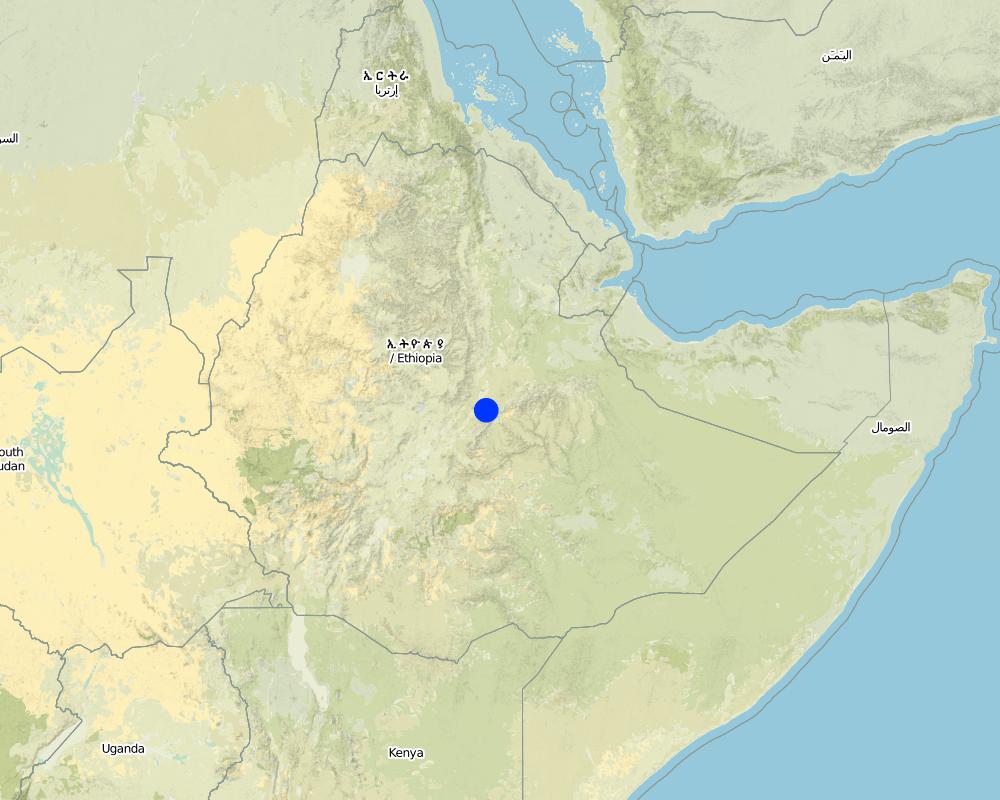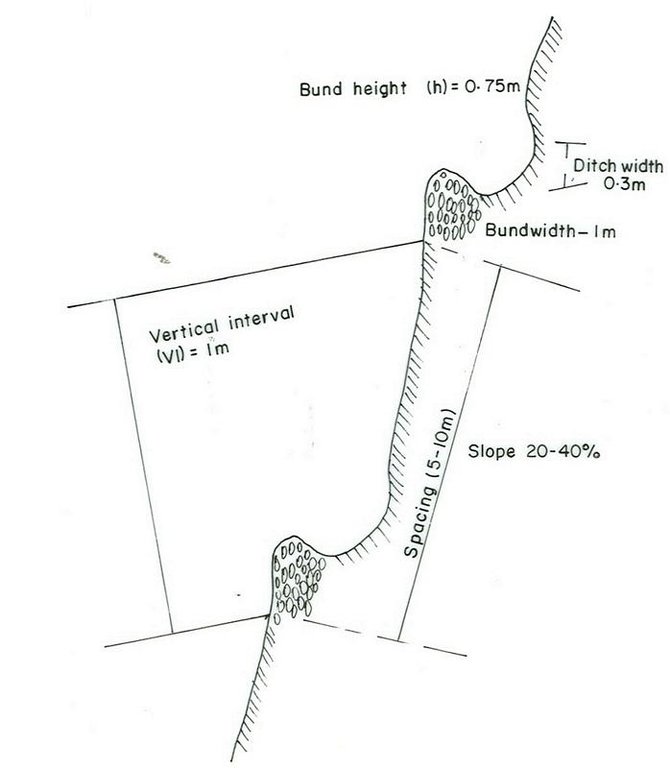Haraghie Stone Bund [埃塞俄比亚]
- 创建:
- 更新:
- 编制者: Unknown User
- 编辑者: –
- 审查者: Fabian Ottiger, Alexandra Gavilano
Duagu ghagaa (Oromiya)
technologies_1076 - 埃塞俄比亚
查看章节
全部展开 全部收起1. 一般信息
1.2 参与该技术评估和文件编制的资源人员和机构的联系方式
关键资源人
SLM专业人员:
Tadesse Getnet
Rural Land and Natural Resources Administration Authority.
埃塞俄比亚
SLM专业人员:
Mekonnen Daniel
Rural Land and Natural Resources Administration Authority.
埃塞俄比亚
1.3 关于使用通过WOCAT记录的数据的条件
编制者和关键资源人员接受有关使用通过WOCAT记录数据的条件。:
是
2. SLM技术的说明
2.1 技术简介
技术定义:
It is constructed along the contour to minimize soil erosion and prevent runoff damage from down stream fields.
2.2 技术的详细说明
说明:
The technology is widely used by farmers in the area and also widely practiced. The structure is built from stone and/or soil. On the average 1m vertical interval is used on a slope of 20-40%.
Purpose of the Technology: The technology is used to increase and maintain crop productivity by promoting activities which improve production and conserve soil and water.
Establishment / maintenance activities and inputs: The embankment is constructed from stone/soil and a ditch is dug at the upper side of the bund and bund stablization technique is used and frequent maintenance made.
Natural / human environment: The technology is suitable to areas with gentle to undulating slope and in cultivated areas with moderate soil depth.
2.5 已应用该技术的、本评估所涵盖的国家/地区/地点
国家:
埃塞俄比亚
区域/州/省:
Oromiya
有关地点的进一步说明:
Awash/Jalela
注释:
Total area covered by the SLM Technology is 239.5 km2.
Map
×2.6 实施日期
如果不知道确切的年份,请说明大概的日期:
- 50多年前(传统)
2.7 技术介绍
详细说明该技术是如何引入的:
- 作为传统系统的一部分(> 50 年)
注释(项目类型等):
Originated locally-farmers developed it from years of experiences.
3. SLM技术的分类
3.1 该技术的主要目的
- 减少、预防、恢复土地退化
- 结合其他技术保护流域/下游区域
3.2 应用该技术的当前土地利用类型

农田
- 一年一作
- 多年一作(非木材)
- 乔木与灌木的种植
每年的生长季节数:
- 2
具体说明:
Longest growing period in days: 150 Longest growing period from month to month: Jul - Dec Second longest growing period in days: 105 Second longest growing period from month to month: Apr - Jun
注释:
Major land use problems (compiler’s opinion): Population pressure, deforestation, land degradation
3.4 供水
该技术所应用土地的供水:
- 雨养
注释:
Water supply: Also mixed rainfed - irrigated
3.5 该技术所属的SLM组
- 横坡措施
3.6 包含该技术的可持续土地管理措施
3.7 该技术强调的主要土地退化类型

土壤水蚀
- Wt:表土流失/地表侵蚀

水质恶化
- Ha:干旱化
注释:
Main type of degradation addressed: Wt: loss of topsoil / surface erosion
Secondary types of degradation addressed: Ha: aridification
Main causes of degradation: deforestation / removal of natural vegetation (incl. forest fires) (clearing forests and bushes for agricultural purpose), over-exploitation of vegetation for domestic use (no vegetation cover/complete denudation), other human induced causes (specify) (agricultural causes - continous farming with out apllying SWC), education, access to knowledge and support services (lack of soil management skill), governance / institutional
Secondary causes of degradation: overgrazing (high population/cattle pressure on the resources), poverty / wealth (lack of captial - unable to use improved technologies), land subdivision (small in size & fragmented), lack of enforcement of legislat./authority (legislation is not inplace)
3.8 防止、减少或恢复土地退化
具体数量名该技术与土地退化有关的目标:
- 防止土地退化
注释:
Secondary goals: mitigation / reduction of land degradation, rehabilitation / reclamation of denuded land
4. 技术规范、实施活动、投入和成本
4.1 该技术的技术图纸
技术规范(与技术图纸相关):
Oromia
Technical knowledge required for field staff / advisors: high
Technical knowledge required for land users: high
Main technical functions: control of dispersed runoff: retain / trap
Secondary technical functions: control of concentrated runoff: retain / trap, reduction of slope angle, reduction of slope length, increase of infiltration, increase / maintain water stored in soil, water harvesting / increase water supply
Better crop cover
Material/ species: farm implements
Remarks: plough along the contour
Aligned: -contour
Vegetative material: T : trees / shrubs, F : fruit trees / shrubs
Vertical interval between rows / strips / blocks (m): 1
Terrace: bench level
Vertical interval between structures (m): 1
Spacing between structures (m): 5-10
Height of bunds/banks/others (m): 0.75
Width of bunds/banks/others (m): 1
Construction material (earth): the excavated soil is used for making the embankment
Construction material (stone): used to construct stone/stone faced bunds
Slope (which determines the spacing indicated above): 15%
Lateral gradient along the structure: 0%
4.2 有关投入和成本计算的一般信息
其它/国家货币(具体说明):
Birr
如相关,注明美元与当地货币的汇率(例如1美元=79.9巴西雷亚尔):1美元=:
8.6
注明雇用劳工的每日平均工资成本:
0.78
4.3 技术建立活动
| 活动 | 时间(季度) | |
|---|---|---|
| 1. | Surveying | dry season |
| 2. | Collection of bund construction materilas | dry season |
| 3. | Excavation | dry season |
| 4. | Bund construction | dry season |
4.4 技术建立所需要的费用和投入
| 对投入进行具体说明 | 单位 | 数量 | 单位成本 | 每项投入的总成本 | 土地使用者承担的成本% | |
|---|---|---|---|---|---|---|
| 劳动力 | Labour | ha | 1.0 | 169.0 | 169.0 | |
| 设备 | Tools | ha | 1.0 | 69.0 | 69.0 | 100.0 |
| 植物材料 | Seeds | ha | 1.0 | |||
| 技术建立所需总成本 | 238.0 | |||||
| 技术建立总成本,美元 | 27.67 | |||||
注释:
Duration of establishment phase: 36 month(s)
4.5 维护/经常性活动
| 活动 | 时间/频率 | |
|---|---|---|
| 1. | Contour plough | dry season & on set of rains / 3-5 times |
| 2. | Sowing | during rains / each cropping season |
| 3. | Weeding | during rains / each cropping season |
| 4. | Bund stablization | dry season/annual |
| 5. | Repair the breaks | dry season/annual |
4.6 维护/经常性活动所需要的费用和投入(每年)
| 对投入进行具体说明 | 单位 | 数量 | 单位成本 | 每项投入的总成本 | 土地使用者承担的成本% | |
|---|---|---|---|---|---|---|
| 劳动力 | Labour | ha | 1.0 | 82.8 | 82.8 | |
| 技术维护所需总成本 | 82.8 | |||||
| 技术维护总成本,美元 | 9.63 | |||||
注释:
The cost is culculated for the stone/soil bund and trench per hectare of land.
4.7 影响成本的最重要因素
描述影响成本的最决定性因素:
Labour is the most important factor affecting the cost.
5. 自然和人文环境
5.1 气候
年降雨量
- < 250毫米
- 251-500毫米
- 501-750毫米
- 751-1,000毫米
- 1,001-1,500毫米
- 1,501-2,000毫米
- 2,001-3,000毫米
- 3,001-4,000毫米
- > 4,000毫米
农业气候带
- 潮湿的
5.2 地形
平均坡度:
- 水平(0-2%)
- 缓降(3-5%)
- 平缓(6-10%)
- 滚坡(11-15%)
- 崎岖(16-30%)
- 陡峭(31-60%)
- 非常陡峭(>60%)
地形:
- 高原/平原
- 山脊
- 山坡
- 山地斜坡
- 麓坡
- 谷底
垂直分布带:
- 0-100 m a.s.l.
- 101-500 m a.s.l.
- 501-1,000 m a.s.l.
- 1,001-1,500 m a.s.l.
- 1,501-2,000 m a.s.l.
- 2,001-2,500 m a.s.l.
- 2,501-3,000 m a.s.l.
- 3,001-4,000 m a.s.l.
- > 4,000 m a.s.l.
关于地形的注释和进一步规范:
Landforms: Hill slopes (ranked 1), plateau/plains (ranked 2) and foot slopes (ranked 3)
Slopes on average: Also rolling (ranked 2) and steep (ranked 3)
5.3 土壤
平均土层深度:
- 非常浅(0-20厘米)
- 浅(21-50厘米)
- 中等深度(51-80厘米)
- 深(81-120厘米)
- 非常深(> 120厘米)
土壤质地(表土):
- 中粒(壤土、粉土)
- 细粒/重质(粘土)
表土有机质:
- 中(1-3%)
- 低(<1%)
如有可能,附上完整的土壤描述或具体说明可用的信息,例如土壤类型、土壤酸碱度、阳离子交换能力、氮、盐度等。:
Soil fertility: Medium (ranked 1), low (ranked 2) and high (ranked 3)
Soil drainage/infiltration is medium
Soil water storage capacity is medium
5.6 应用该技术的土地使用者的特征
生产系统的市场定位:
- 生计(自给)
- 混合(生计/商业)
非农收入:
- 低于全部收入的10%
相对财富水平:
- 非常贫瘠
- 贫瘠
机械化水平:
- 手工作业
- 畜力牵引
说明土地使用者的其他有关特征:
Population density: 100-200 persons/km2
Annual population growth: 3% - 4%
20% of the land users are average wealthy and own 35% of the land.
50% of the land users are poor and own 45% of the land.
30% of the land users are poor and own 20% of the land.
Off-farm income specification: Farmers who have implemented SWC technologies on their farms have got better crop yields compared to those who have not implement SWC technologies.
5.7 应用该技术的土地使用者使用的平均土地面积
- < 0.5 公顷
- 0.5-1 公顷
- 1-2 公顷
- 2-5公顷
- 5-15公顷
- 15-50公顷
- 50-100公顷
- 100-500公顷
- 500-1,000公顷
- 1,000-10,000公顷
- > 10,000公顷
注释:
1-2 ha: Only few households
5.8 土地所有权、土地使用权和水使用权
土地所有权:
- 州
6. 影响和结论性说明
6.1 该技术的现场影响
社会经济效应
生产
作物生产
生产区域
土地管理
收入和成本
农业收入
工作量
社会文化影响
社区机构
国家机构
SLM/土地退化知识
生态影响
土壤
土壤水分
土壤流失
6.2 该技术的场外影响已经显现
旱季稳定可靠的水流
下游洪水
下游淤积
6.4 成本效益分析
技术收益与技术建立成本相比如何(从土地使用者的角度看)?
短期回报:
中性/平衡
长期回报:
稍微积极
技术收益与技术维护成本/经常性成本相比如何(从土地使用者的角度看)?
短期回报:
中性/平衡
长期回报:
稍微积极
6.5 技术采用
如若可行,进行量化(住户数量和/或覆盖面积):
1049
在所有采用这项技术的人当中,有多少人是自发的,即未获得任何物质奖励/付款?:
- 11-50%
注释:
70% of land user families have adopted the Technology with external material support
734 land user families have adopted the Technology with external material support
Comments on acceptance with external material support: survey results
30% of land user families have adopted the Technology without any external material support
315 land user families have adopted the Technology without any external material support
Comments on spontaneous adoption: survey results
There is a moderate trend towards spontaneous adoption of the Technology
6.7 该技术的优点/长处/机会
| 土地使用者眼中的长处/优势/机会 |
|---|
|
Reduce erosion and runoff How can they be sustained / enhanced? Regular maintenance |
| 编制者或其他关键资源人员认为的长处/优势/机会 |
|---|
|
Reduction of soil erosion How can they be sustained / enhanced? Regular maintenance |
| Increase infiltration rate |
7. 参考和链接
7.1 信息的方法/来源
链接和模块
全部展开 全部收起链接
无链接
模块
无模块



